Katie Delaney
Madison Early Childhood Center
Elmhurst, IL
Fall 2020 to Spring 2021
This project lasted eight weeks and took place at our center that serves children ages 3 through 5 in half-day sessions. Funding is provided by tuition, the local school district, and the statewide Preschool for All (PFA) program.
Sixteen students from the afternoon session participated in this project. Of those 16 students, six students had Individualized Education Programs (IEPs), two students had speech-only IEPs, two students were English language learners, four were PFA students, and five were tuition-based students. All but one child were going to kindergarten the following year.
Phase 1: Beginning the Project
This project took place during the 2020–2021 school year. We had recently returned to in-person instruction amid COVID. As I consider project topics for my students, I am always listening and observing to find common interests among the students. I was hoping to provide experiences that would interest my students in a project topic that would allow them to give back to the community.
In the beginning of the year, I reached out to parents to ask them to complete a brief survey about topics on which they could serve as guest experts, based on their professions, hobbies, and/or interests. From this survey, I learned that one parent is passionate about fostering, advocating for, and taking care of dogs. I reached out to the parent to see whether she would be willing to talk to our class about her involvement in an organization called Live Like Roo because I know that many of my students have pets, specifically dogs.
Live Like Roo is a nonprofit organization that fosters animals in their final stages of life. The parent agreed and was happy to join our class via Zoom to talk about Live Like Roo. After this initial Zoom meeting, I thought we could extend what we learned about the organization by making get well cards and blankets for the sick animals.
I was not expecting that my students would be so highly motivated and excited by what they learned during the Zoom call. The parent explained what they do to support animals at Live Like Roo. She explained how families foster animals and how Live Like Roo makes and sends the families care packages for each animal. The care packages consist of blankets, toys, McDonald’s gift cards, and get well cards.
My students were very interested in learning more about the McDonald’s gift card part of the care packages. They wondered, “Why are they putting the gift cards in the care packages?” She explained that the dogs are very sick and if their owners buy them ice cream, hamburgers, or cheeseburgers, it makes them feel better. The children were fascinated by the idea that the animals got to eat McDonald’s. This was a huge hook, and I realized that this could become a highly engaging project topic that allowed students to give back to the community.
In the following days, we made lists to share what we knew about animals, specifically pets (see Figure 1). We recorded our ideas about who had pets (and what types), what pets need to live, how to take care of pets, and how we can help our pets stay healthy. We also recorded the questions that the kids had about pets.
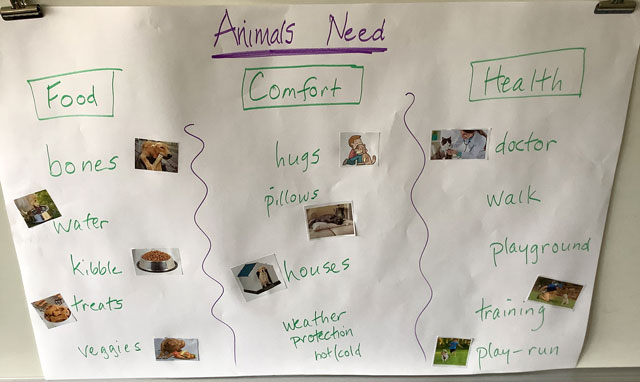
They continued to be interested in how they could help the animals at Live Like Roo. I was excited their interests centered around giving back to the community and service. Throughout the investigation, we regularly added more questions to our list. Each time the children answered one of their questions, we put an X next to it so we could keep track of what they still needed to answer.
The questions on our list included:
- How can we help the animals at Live Like Roo?
- How can we get money to buy McDonald’s gift cards for care packages?
- What do animals eat?
- How do you take care of animals?
- What is a pet?
- How do they stay healthy?
- Do they live inside or outside?
- Do they wear clothes?
My expectation for the project was for the children to understand that they were working together to give back to the community: a service project. I wanted them to walk away from this project with an awareness and understanding that they can always help others and not necessarily expect anything in return.
Phase 2: Developing the Project
To begin our investigation during this phase, we focused on a question one student asked, “How can we help the animals at Live Like Roo?” Through a class conversation the students realized that they wanted to help Live Like Roo make care packages. And they realized that to do so, they might need to raise money to buy gift cards. This led to a new question: How can we make money? We made a list of the ideas the students had, such as have a lemonade stand, hold a bake sale, tell our parents we want money.
I led a discussion that helped connect their knowledge about pets and pet care to ideas for fundraising. They remembered that dogs like to eat treats and cats play with little toys. One student had an idea that we could make dog treats and get money for them. Then another student chimed in to say we could make cat toys, too. Other students added that maybe they could get money for giving treats or toys to cat and dog owners that we know.
I told my students that this could be called a donation and that people could choose to donate money for the items that we planned to make. I explained that a donation can be for any amount of money that a person wants to give. The children agreed that this would be a great way to make money for Live Like Roo.
The first thing we decided to do make was dog treats. This led them to wonder about how to make dog treats. What ingredients do you need? We searched on the internet to find dog treat recipes. We found and followed a recipe that we could bake at school (see Figure 2).
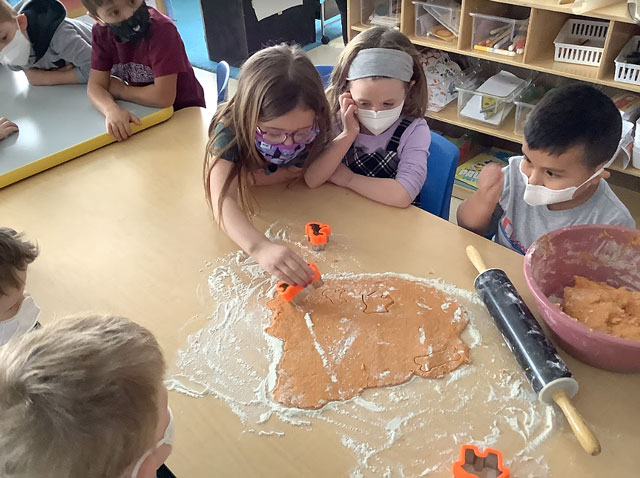
Next, we needed to make cat toys, which prompted another new question: “What types of toys do cats play with?” To find answers, we asked peers who had cats, and we also researched by looking at pictures in books and on the internet. Based on our research, we decided to make three different types of cat toys using a variety of art supplies and materials. The students had to think about designs and materials that were safe for cats and that the kids could independently make. One cat toy was a ping-pong ball filled with rice and wrapped with duct tape. The second was pipe cleaners wrapped around markers. The third was toilet paper tubes; we snipped the ends and wrapped the rest with duct tape (see Figure 3).

As the students were actively engaged in making the treats and toys, I was collecting video footage. I also asked them about what they were doing and why. I used the footage to create a video that would help spread awareness about our project and help us get donations. I shared this video with parents and the school community. Parents also shared this video with extended family members.
After we had gained awareness about our service project through our video, we made order forms, passed them around the school, and sent them home so people could order dog treats and cat toys (see Figure 4).
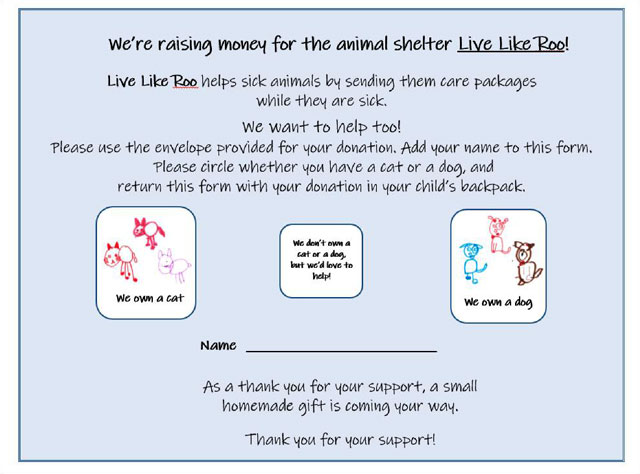
Creating the order forms was a process as well. We wanted to come up with a logo, so the students drew cat and dog submissions. We spent several days deciding which cat and which dog drawings we wanted to use on our flyers as our logo. The children voted, and we ended up using a few of their favorites.
Not only did we use the logo on the flyer, but once we received an order, we packaged the treat or toy in a bag with a sticker on it that included the logo and a thank you message. If the order was for a person who worked in our school, some of the students would hand deliver it to them. If the order was for someone at home, the student took the packaged order home in their backpack.
We initially made one batch of dog treats to fulfill our orders, and we had numerous staff and family members reply to our order forms asking for dog/cat treats. We quickly realized we needed to make more treats as the orders kept coming in. When people submitted their forms, they attached a donation. We raised more than $1,000 (see Figure 5).
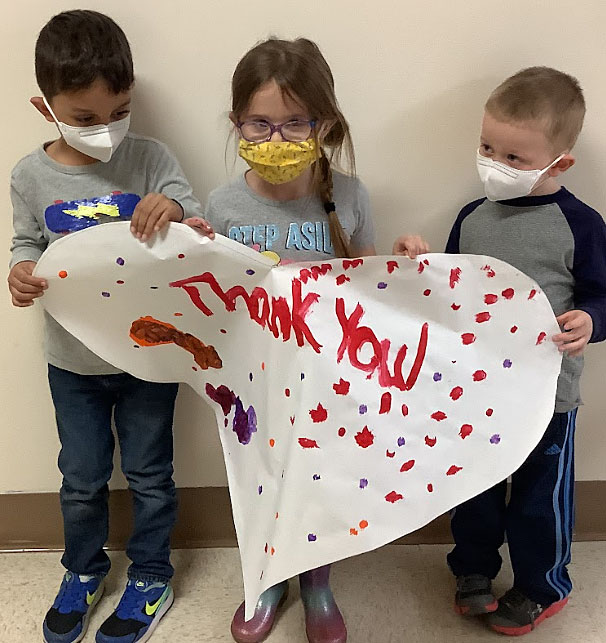
As part of our field site investigation, we walked to a local pet store called Ruff Life where we dropped off a basket of our cat toys with a donation letter explaining our project. The owner said we could put our basket on the counter to help us get more donations. A couple of weeks later we walked back to pick up our basket and collect donations. When we were standing outside of Ruff Life, we took a class photo that was later published in the local newspaper with a description of our community service project (see Figure 6).
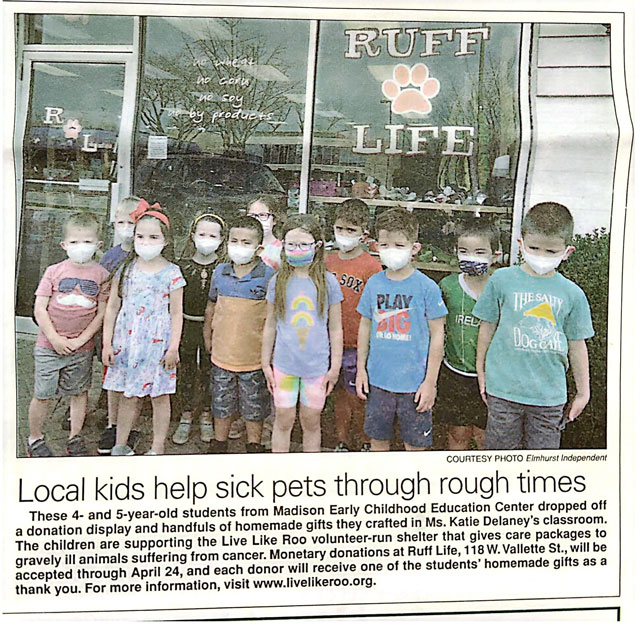
Throughout the project I involved parents in a variety of ways. I used Seesaw (an app-based platform that I use to share student photos and communicate with families) regularly during the project so parents knew what we were working on in class and so they could extend that learning at home by talking about it with their child. I shared the class video with families that talked about the service project and also sent flyers home so parents could order and donate.
During the project we had one class member who joined remotely every day because of COVID. I communicated regularly with his parents so he could be actively involved in our project. For example, he followed the recipe to make the dog treats and cat toys from home.
Phase 3: Concluding the Project
After the students filled all the orders and counted the money they had raised, I worked with them to come up with a plan for what to do with the money. First, I found the Amazon Wish List that was created by Live Like Roo for items the dogs needed. I projected the wish list on our classroom large screen to show the children. Together, we went through the list, and I asked the students what they thought they should buy for the animals. With the money they collected, they were able to buy at least one of each item on the wish list. Items included squeaky toys, balls, plush toys, and chew toys. These items would all go into the care packages.
Next, we planned a walking field trip to the local McDonald’s. We used a portion of the money we raised to buy gift cards for the Live Like Roo care packages. These are the gift cards the owners can use to buy treats for their pets. This was a full circle moment for the students. From the first time they learned about Live Like Roo, the students were inspired and motivated to figure out how to buy McDonald’s gift cards for the care packages. They did it!
While at McDonald’s, I surprised the students by buying them ice cream. The students were not expecting this and were happy to have the treat (see Figure 7). I told them I wanted to give them this treat to celebrate their hard work.
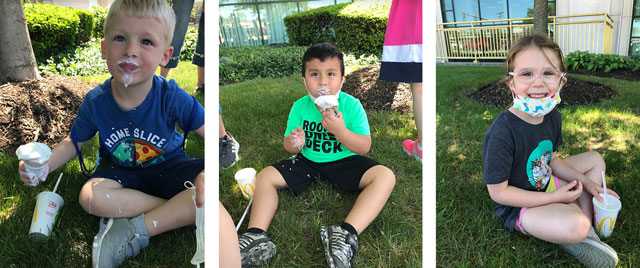
We walked back to school and put the gift cards in boxes along with blankets and the get well cards we made. Once Live Like Roo received our boxes, along with the items from Amazon, they were repackaged and sent to the ailing pets’ families.
As a result of participating in this project, the students learned that it is good to think about others and help other people or animals. They experienced first hand that you don’t need something tangible to feel good. They discovered different places in our community such as the nonprofit Live Like Roo and the pet store Ruff Life. They learned how to make dog treats and cat toys. They realized that instead of just asking their parents for money, you can think outside the box and earn money yourself. They learned what it means to make a donation and the greater impact that several donations can have.
Teacher Reflection
Whenever I reflect back on this project, it brings a smile to my face. This service project was meaningful to me because it grew so big, thanks to the children and their desire to help sick animals. Once they heard that the animals could eat McDonald’s, there was no turning back. The children needed to figure out how to get money to buy the gift cards. If it wasn’t for McDonald’s and the way they market to children, I’m not sure this project would have been so inspiring to them. I am now grateful for the way McDonald’s zones in on children.
When I was thinking about starting a project, I decided that I wanted it to be service orientated. I liked the idea of having the children do something to give back to the community, and I wanted them to realize that they are not too young to help others. The children were excited throughout the project because each day we were busy creating cards, baking, making toys, or delivering thank you gifts. It was quite an undertaking.
Although the class had children with varying abilities and backgrounds, everyone was able to participate. In fact, this project brought these children together into a close knit, cohesive team. There was one child in particular who was very shy and introverted. For example, when she did come to school, she would cry and she would not talk at all.
As the project developed and she became more interested and invested, she began to blossom. She loved making the cat toys because she had cats at home. The connection to this project really helped her grow. She became more comfortable at school, opened up, and even formed a few friendships.
I would definitely do a service project again. It’s a win-win for everyone!
Also participating in the project were Anna Robins, a speech-language pathologist, and Tisha Hickey and Millie Rodriguez, paraprofessionals and school-related personnel.


